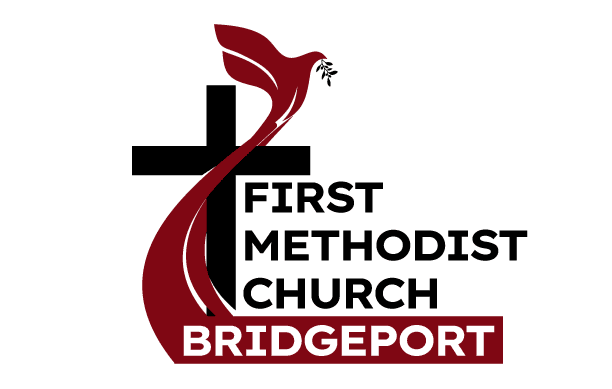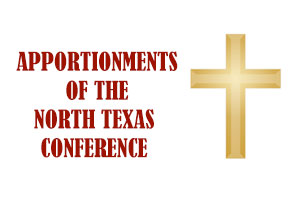2013 Apportionments of the North Texas Conference

A BRIEF DESCRIPTION OF THE 2013
APPORTIONMENTS OF THE NORTH TEXAS CONFERENCE
GENERAL CONFERENCE
WORLD SERVICE:
The basic benevolence fund of our church, distributed to various program agencies by a precise formula to support their missional responsibilities. The agencies serve both as a resource to local churches and an extension of local churches in action on a national and world level primarily through World Service budgets.
MINISTERIAL EDUCATION FUND:
Money for theological seminaries and continuing education programs with 75% being administered by the general church and 25% by our Annual Conference.
BLACK COLLEGES FUND:
Financial help to upgrade the standards of buildings, facilities and operational expenses of the ten Black Methodist colleges and one Black Methodist medical school.
AFRICA UNIVERSITY FUND:
Funds for the development of the first private university in sub-Sahara Africa.
EPISCOPAL FUND:
The salary, travel, and office expenses for the bishops of The United Methodist Church.
INTERDENOMINATIONAL COOPERATION FUND:
The support for general church activities, ecumenical in nature, so that United Methodism might be in mission and ministry with other Christian communions.
GENERAL ADMINISTRATION FUND:
The funding of administrative work on the church’s general level, including the cost of holding General Conference and financing church agencies administrative in nature.
JURISDICTIONAL CONFERENCE
LYDIA PATTERSON INSTITUTE:
A special project of the South Central Jurisdiction for the Mexican-American School in El Paso, Texas.
MT. SEQUOYAH ASSEMBLY:
Support for our jurisdictional facility in Fayetteville, Arkansas, used as a retreat and training center.
SMU CAMPUS MINISTRY:
Financial support, along with other annual conferences in the jurisdiction, for personnel and programs for the campus ministry at Southern Methodist University.
ANNUAL CONFERENCE
LEADERSHIP DEVELOPMENT:
funds for the Center for Leadership Development, which is responsible for identifying, recruiting, equipping and developing young, diverse, lay and clergy principled Christian leaders. Includes our work in faith development and discipleship and the Board of Ordained Ministry, the Board of Laity and the Conference Council on Youth Ministries.
NEW CHURCH DEVELOPMENT & CONGREGATIONAL TRANSFORMATION:
funds for the Center for New Church Development & Congregational Transformation, which is responsible for starting new faith communities and transforming existing congregations.
MISSIONAL OUTREACH:
funds for the Center for Missional Outreach, which is responsible for our ministry with the poor and our efforts to improve global health.
CONNECTIONAL RESOURCES:
funds for the Center for Connectional Resources, which is responsible for providing the necessary services to leverage our resources and support our efforts to address the priorities of the Annual Conference. Includes the central treasury, clergy and staff benefits, property concerns including the conference-wide property & liability insurance program, administrative support services, and camp and retreat center operations.
BOARD OF PENSION AND HEALTH BENEFITS:
funds for the Comprehensive Protection Plan (disability and life insurance) for pastors, pension supplements for those churches and pastors whose compensation is under the Denominational Average Compensation, and Board of Pension and Health Benefits operating expenses. Also includes supplemental funds for health insurance premiums for current retired ministers and pastors and dependents whose salaries are below the denominational average compensation, and funding for our past pension and retiree medical liability obligations.
AREA ADMINISTRATION:
funds for the Bishop’s Office and residence, including the conference Communications Office.
DISTRICT SUPERINTENDENTS:
the salaries, expenses, and benefits for the four district superintendents in the North Texas Conference, as well as the Cabinet Emergency Fund.
DISTRICT ADMINISTRATION FUND:
funds for income for the expenses and operation of the district offices and programs as well as providing upkeep on district parsonages.
QUESTIONS OFTEN ASKED ABOUT APPORTIONMENTS
NORTH TEXAS CONFERENCE – 2012
1. Who make decisions about apportionments?
- Members from local congregations at Annual Conference.
- Members from local congregations, who are elected delegates to Jurisdictional & General Conference quadrennially.
- Members from local congregations at District Conference.
2. Who are members of these conferences?
- One lay member of the Annual Conference is elected annually from every charge. In addition, larger churches elect one lay member for each clergy appointed to serve that church. The district conferences elect additional lay members to equalize the number of lay and clergy members.
- General and Jurisdictional Conference delegates are elected every four years on a general church-wide ratio according to the number of ministerial and church members of the Annual Conference. An equal number of lay and clergy delegates are elected to the General and Jurisdictional Conferences by the Annual Conference.
- The district conferences of the Annual Conference include all lay and clergy members of the Annual Conference from the churches of the districts.
3. Who determines how much each church is apportioned?
- The Annual Conference determines annually how the total amount of each apportionment is to be divided among the several churches based on the two-part decimal (1/3 membership – 2/3 finance) formula with one exception:
- The formulas for the district budgets are set by the district conferences.
4. How is the two-part decimal (membership – finance) formula computed for each church?
- The membership part is computed by dividing the total 2010 church membership of the Annual Conference (less discontinued churches and fellowships = 150,332) into the 2010 membership of each church. This becomes the church’s membership decimal.
- The finance part is computed by adding the amounts of the operating expenses reported paid by each church in columns 53, 54, 56 – 58, and 60 – 62 of the 2010 Statistician’s Report. (No funds reported in other statistical columns are included in this computation.) This total is then divided by the Conference total of these same columns (less discontinued churches and fellowships = $79,969,615). This becomes the local church’s finance decimal.
5. Must churches pay all their apportionments?
- Payment of all apportionments is a spiritual matter and connectional responsibility. In addition, however, according to paragraph 621 of the 2004 Discipline, the Episcopal Fund, the District Superintendents Fund, Board of Pensions, and Equitable Compensation Fund are to be paid according to the same schedule as the pastor’s salary is paid.
6. When should apportionments be paid?
- Apportionments should be paid monthly. With the exception of a part of the Board of Pensions Fund, all apportionments support current budgets of connectional causes. The various ministries are made less effective when monthly operating expenses are limited because apportionments are not paid on a monthly basis.
- The Annual Conference has recommended “that local churches plan to remit at least 10% of their annual apportionments before the 15th of each month beginning in January or February” (2009 Conference Journal, p.192).




